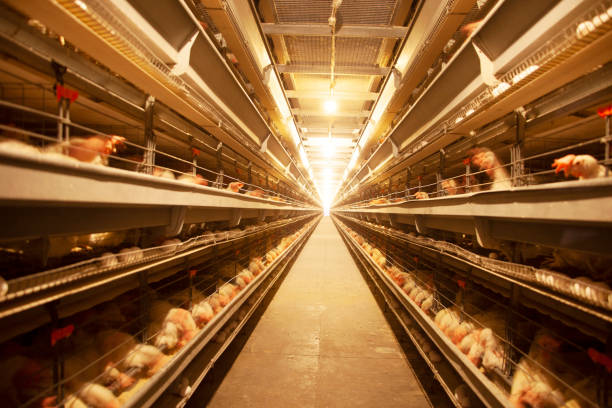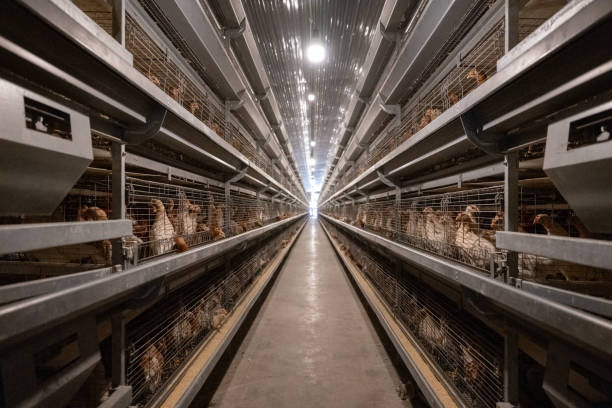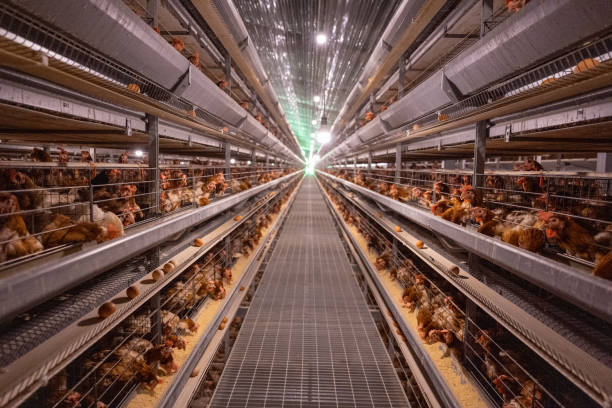
Scaling Up: The Ultimate 20,000 Bird Poultry Cage System for African Farmers
Scaling Up: The Ultimate 20,000 Bird Poultry Cage System for African Farmers
For African farmers eyeing serious growth in their poultry operations, scaling up to a 20,000-bird capacity demands a robust and meticulously planned infrastructure. Forget the romantic notion of rambling free-range chickens; we’re talking about a commercially viable enterprise, and for that, a well-designed poultry cage system is paramount. This guide delves into the critical aspects of implementing a 20,000-bird cage system, offering practical insights to help African farmers maximize efficiency, profitability, and sustainability.
The Case for Cages: Addressing Misconceptions
Before diving into the specifics, let’s confront the common misconceptions surrounding poultry cages. The term “cage” often conjures up images of cramped, inhumane conditions. However, modern cage systems, designed with animal welfare in mind, offer substantial advantages over traditional floor systems, particularly at this scale.
Improved Hygiene: Cages elevate birds above their manure, significantly reducing the risk of disease outbreaks. This translates into lower mortality rates and reduced reliance on antibiotics.
Enhanced Feed Efficiency: With individual access to feed and water, birds in cages experience less competition, leading to more uniform growth and reduced feed wastage.
Easier Management: Cages facilitate easier monitoring of individual birds, allowing for early detection of health problems and targeted interventions. Egg collection and manure removal are also streamlined, minimizing labor costs.
Optimized Space Utilization: Cage systems make the most of available space, allowing for a higher bird density compared to floor systems. This is crucial for maximizing production and profitability.
Choosing the Right Cage System: Battery vs. Layer Cages
For a 20,000-bird operation, two primary cage system options exist: battery cages (specifically for broilers) and layer cages (for egg-laying hens).
Battery Cages: These are designed for meat production. Birds are typically raised in these cages from chick stage until slaughter weight is achieved (usually around 6-8 weeks). The cage design focuses on rapid growth and efficient feed conversion. Key features include adequate floor space per bird, nipple drinking systems, and efficient manure removal mechanisms. Sturdy construction is vital to withstand the rapid growth of the birds and frequent cleaning cycles. Ventilation is a crucial design element to manage the build-up of ammonia and maintain air quality within the poultry shed.
Layer Cages: Layer cages, specifically for egg production, come in various configurations, most commonly A-frame or H-frame systems. These cages provide hens with individual nesting areas, feeding troughs, and water lines. Egg collection can be manual or automated, depending on the scale of the operation and budget. Slatted floors allow manure to drop through into collection channels below, simplifying cleaning and improving hygiene. Cage size and design are critical to ensure the hens have enough space to move comfortably and exhibit natural behaviors, such as perching and dustbathing (if enriched cages are selected).
The decision between battery and layer cages depends entirely on the farmer’s primary goal: meat or egg production. Layer cages are by far the most prevalent when discussing poultry cage systems for 20,000 birds in an African context, due to the higher profit margins associated with large-scale egg production.
Key Considerations for Cage System Selection
Several factors should guide your choice of cage system:
Climate: African climates vary widely, so choose a system that can withstand the local conditions. Hot climates necessitate robust ventilation and cooling systems, while colder regions require insulation and heating.
Manure Management: Efficient manure removal is essential for hygiene and odor control. Consider automated manure belts or flushing systems to minimize labor and environmental impact.
Automation: Automation can significantly reduce labor costs and improve efficiency. Options include automated feeding, watering, egg collection, and manure removal.
Biosecurity: The cage system should facilitate effective biosecurity measures to prevent disease outbreaks. Easy cleaning and disinfection are critical, as well as controlled access to the poultry house.
Bird Welfare: Choose a system that prioritizes bird welfare. Adequate space, access to fresh water and feed, and proper ventilation are essential for healthy and productive hens. Enriched cages, which provide additional features such as perches and dust baths, are increasingly popular due to growing consumer awareness of animal welfare.
Building the Poultry House: A Foundation for Success
The poultry house is more than just a shelter; it’s a controlled environment that directly impacts bird health and productivity.

Location: Choose a location that is accessible to transportation, has a reliable water supply, and is दूर from residential areas to minimize noise complaints and disease transmission.
Size: A 20,000-bird operation requires a substantial building. Consult with experienced poultry farm builders to determine the optimal dimensions based on the chosen cage system and local building codes.
Ventilation: Adequate ventilation is critical for removing moisture, ammonia, and carbon dioxide. Natural ventilation can be supplemented with fans and exhaust systems, especially in hot climates. Tunnel ventilation, which draws air through the length of the building, is a highly effective method for maintaining optimal air quality and temperature.
Insulation: Insulation helps maintain a consistent temperature inside the poultry house, reducing energy consumption for heating and cooling.

Lighting: A well-designed lighting system is crucial for stimulating egg production. Implement a controlled lighting program to optimize laying performance. LED lighting is energy-efficient and provides consistent light quality.
Flooring: Concrete floors are durable, easy to clean, and provide a solid foundation for the cage system.
Essential Equipment and Infrastructure

Beyond the cages and poultry house, several other essential components are necessary for a successful 20,000-bird operation.
Feeding System: Choose a feeding system that provides consistent and uniform feed distribution. Automated feeding systems can significantly reduce labor costs. Auger systems and chain feeding systems are commonly used.
Watering System: Nipple drinking systems are hygienic and efficient, providing birds with constant access to fresh water. Ensure adequate water pressure and filtration.
Egg Collection System: Manual or automated egg collection systems are available. Automated systems reduce labor costs and minimize egg breakage.
Manure Management System: Choose a manure management system that complies with local environmental regulations. Options include manure belts, flushing systems, and composting.
Biosecurity Measures: Implement strict biosecurity protocols to prevent disease outbreaks. This includes controlling access to the poultry house, disinfecting equipment, and implementing a vaccination program. Foot baths and vehicle disinfection stations are essential.
Generator: A backup generator is crucial for ensuring continuous operation during power outages. This is particularly important for maintaining ventilation and temperature control.
Financial Considerations: Investment and ROI
Scaling up to a 20,000-bird operation requires a significant investment. Costs include the cage system, poultry house construction, equipment, birds, feed, and labor. Developing a detailed business plan is crucial for securing financing and ensuring profitability.
Cost Analysis: Conduct a thorough cost analysis to determine the total investment required.
Revenue Projections: Estimate your potential revenue based on egg production or meat sales.
Profitability Analysis: Determine your break-even point and potential profit margins.
Return on Investment (ROI): Calculate the expected ROI to assess the financial viability of the project.
Seeking Expert Advice and Support
Implementing a 20,000-bird cage system is a complex undertaking. Seek advice from experienced poultry consultants, equipment suppliers, and agricultural extension officers. They can provide valuable guidance on all aspects of the operation, from cage system selection to biosecurity protocols.
Poultry Consultants: Consultants can help you develop a comprehensive business plan, optimize your production practices, and troubleshoot problems.
Equipment Suppliers: Choose a reputable equipment supplier who can provide high-quality equipment, installation services, and ongoing support. Livi Machinery is a good option for poultry cages in Africa.
Agricultural Extension Officers: These officers can provide valuable information on local regulations, best management practices, and available resources.
Sustaining Success: Long-Term Management
Once the system is in place, ongoing management is critical for sustained success.
Monitoring Bird Health: Regularly monitor the health of your birds for signs of disease or stress.
Feed Management: Monitor feed consumption and adjust feed rations as needed.
Water Management: Ensure birds have constant access to clean, fresh water.
Hygiene and Sanitation: Maintain a strict hygiene and sanitation program to prevent disease outbreaks.
Record Keeping: Keep accurate records of production, expenses, and mortality rates to track performance and identify areas for improvement.
Scaling up to a 20,000-bird poultry cage system presents a significant opportunity for African farmers to increase production, improve efficiency, and boost profitability. By carefully considering the factors outlined in this guide, farmers can make informed decisions and build a successful and sustainable poultry operation. Remember, investing in quality equipment, prioritizing bird welfare, and seeking expert advice are essential for maximizing your return on investment and ensuring long-term success. The future of poultry farming in Africa is bright, and embracing modern cage systems is a key step towards realizing that potential.
